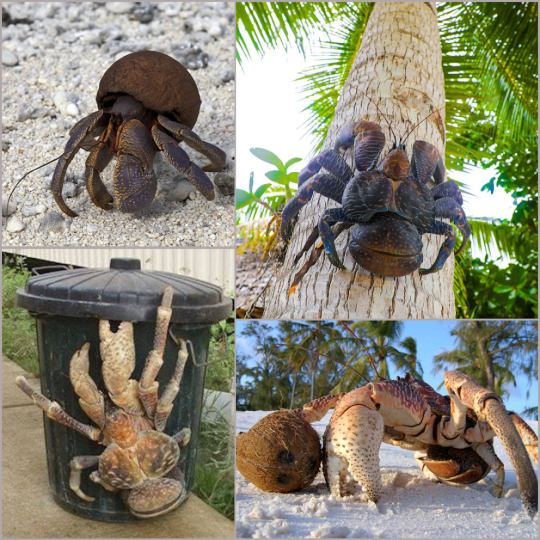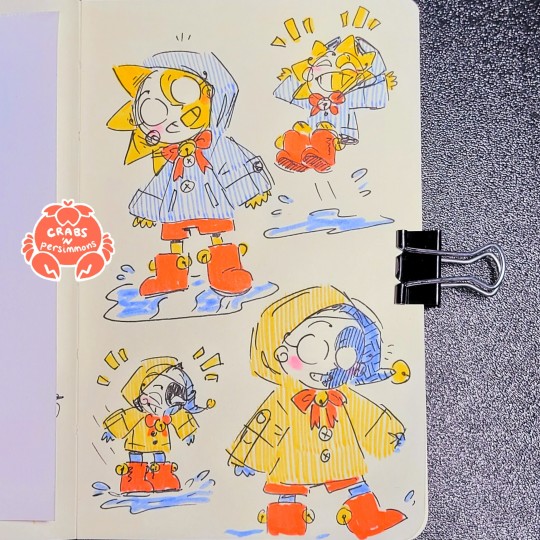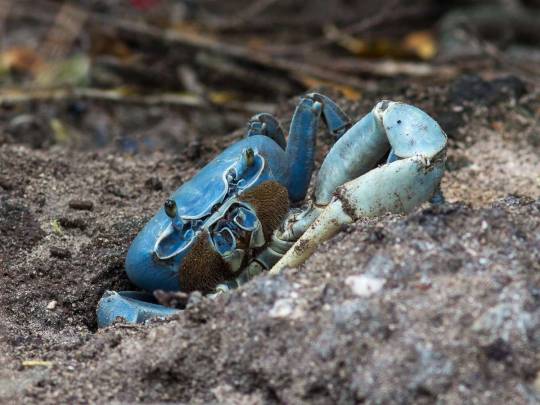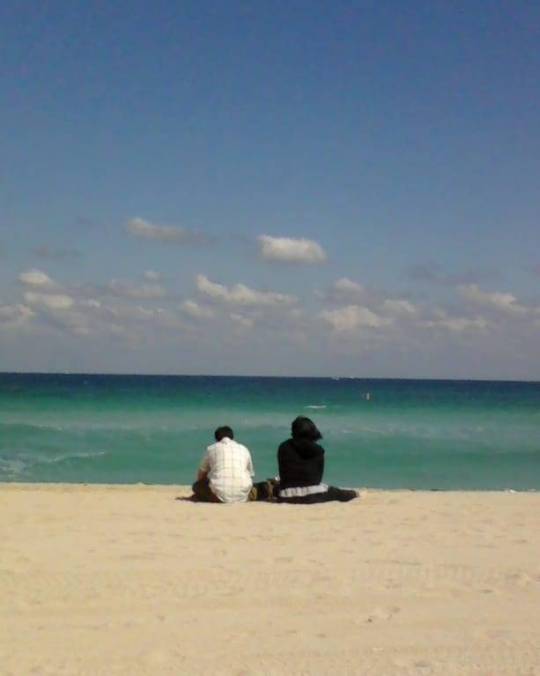#land crabs
Explore tagged Tumblr posts
Note
coconut crab?
Today on CHUNK! FUNK! GUNK! We rate
the COCONUT CRAB:

5/10 Chunk
8/10 Funk
0-1/10 Gunk
Here you go, crab enjoyer. I know you’ve been asking for coconut crab for a while now lol
What a big guy! Though it is a crab and therefore majority carapace instead of skin or fat, it does have a big ol’ badonker so it can get a little chunk. While it is a pretty regular looking crab in my opinion, I do think that it is recognizable when compared to other crabs. Especially since I believe that it’s one of the largest (or THE largest) species of land crab. It gets to have a little higher than average funk. I could not find any information on its slime or mucous secretion, so I am left to assume that it is a dry little guy.
Overall: 5/10
A very solid and interesting crab. I feel like I would find them a lot more interesting if I could see one in real life, but from photos alone it does not have the ‘wow factor’ for me.
#chunk funk gunk#chunk#funk#gunk#coconut crab#land crabs#land crab#good crabs#crabs#crab#crabs crabs crabs#time for crab#crab rave#asks open
459 notes
·
View notes
Text
Although land crabs regularly appear in the exotic pet trade, there is not much care information around for these species, excepting the most widely traded of the land hermit crabs, Coenobita clypeatus. For a while much confusion surrounded the rainbow crab of West Africa, Cardisoma armatum, and the moon crabs of the grnus Gecarcinus, which are imported from the opposite side of the Atlantic. I had myself thought the moon crabs, traded at a smaller size than the rainbow crabs, were a growth stage of that species. The similarities were not merely superficial, because both genera are members of Gecarcinidae, a major clade of land dwelling crabs. At least two species of Gecarcinus were turning up, these being G. lateralis and G. quadratus.
A well studied species, G. lateralis might be thought of as the ordinary moon crab, and most of my scientific information pertains from descriptions of this species, which is also called the Bermuda land crab and the black-back land crab, as well as some other names. Whatever it is being called, G. lateralis is present in coastal environments, where it lives above the tide mark, including where there is no standing water. Reportedly G. lateralis can grow to attain a carapace as long as 10 to even 12 centimeters, or 4 to almost 5 inches, and a legspan that is 15 centimeters or 6 inches. If such specimens exist then they are rare. A study of the burrowing behavior of this species in forest habitat, did not indicate any of such large crabs, their carapaces measuring closer to 5 centimeters or 2 inches when mature. However in a related species, G. ruricola, large males and slightly smaller females are demonstrated to possess carapaces about 9 centimeters wide, whilst 5 or 6 centimeters would be a more common carapace width.
The related species G. quadratus also has many names, but the Halloween (moon or land) crab is by far the most widely encountered, at least in the exotic pet trade. It may also be encountered with the labelling of harlequin land crab, among others. These two names do not seem to be in use when referring to any other Gecarcinus species, all of which may for example be referred to as red land crabs or moon crabs - labels shared with land crabs from other gecarcinid genera. G. quadratus is a native of the coastal rainforests of Mexico and the Panamanian land bridge, that attaches North to South America. This species has a carapace length of about 5 centimeters or 2 inches. I do not have a clue as to how variable in size this species of Gecarcinus is. Although it is clear that mature members of species in Gecarcinus, may show size variation.
Although Gecarcinus sp. larvae are dependent upon saltwater for their survival, the adult crabs have no such requirement. Although they might be found on beaches and in estuarine environments, adult G. lateralis died at salinities of 30 and 35 ppt, whereas they flourished in freshwater, and at lower salinities of 15 and 20 ppt. I do not have information about the salinity tolerance of G. quadratus, but adults belonging to both species do perfectly fine with access only to fresh water. These crabs are obligate air breathers and no not, in fact, require an aquaterrarium, provided their substrate is damp, or they have access to shallow water in a bowl or dish. This is because these crabs take up water using their abdomens. G. lateralis is also known to ingest damp sand for its moisture content.
Both G. lateralis and G. quadratus are present in environments where the substrate allows for burrowing behavior, and there is plenty leaf litter. Conspecific crabs are present in vast numbers, might share an environment, and this might be thought apt for these species the aquaterrarium, considering their herding habits in the wild. Nonetheless, each of these crabs will need space to avoid the behavioral incidents arising from overstocking. Cohabiting crabs would also need a complex environment, which they can use to avoid confrontations among their kind when necessary, not least if they are molting, because the presence of conspecifics reduces the survival of molting crabs. These crabs molt inside their own burrows for protection during this vulnerable, temporary time. Although this genus has strong herbivorous leanings, the older crabs are known to kill their juvenile conspecifics for food, especially when they are under nutrient stress
Gecarcinus are classed among the herbivorous crabs, and they do possess the abilities to digest cellulose, and consume fibrous plant materials. However their herbivory is not total, and foods of animal origins are accepted. Their diets are 80% vegetarian whereas it is only 10% of arthropod origins, and they can consume both green and brown (dead) plant matter. Although they prefer to eat fresh plant material, the wild crabs might consume more leaf litter. G. lateralis is a significant consumer of seeds, fruits, and propagules, avoiding vegetable foods with strong alkaloid defences. There is reason to believe genus Gecarcinus consume a broader spectrum of foods in the dry season, including fruits and carrion. Cannibalism in these crabs increases when access to nitrogen is decreased.
Gecarcinus sp. are burrowing crabs, and they use their burrows to shelter in less hospitable seasons, plugging their burrow and storing leaves as their food supply, when the temperature drops and the air humidity decreases. This behavior assists them avoiding water loss in the dry season. For this reason the air temperatures in the vivarium housing Gecarcinus sp. should not drop as low as 15-18 degrees centigrade, unless one wishes to stimulate such behaviors, by simulating a Caribbean dry season. The crabs seem to use decreasing air temperature as their cue for this behavior, but are triggered to resume behavioral normalcy by increased rains and the return of higher air humidity.
These crabs in the vivarium require a dump substrate and a high air humidity of over 80%, based on the humidity inside crab burrows. The diurnal air temperature range, on a similar basis, should be closer to 28 degrees than to 20 degrees centigrade. People report success when keeping this species at 26 or 27 degrees by day. I have read that this temperature must not be allowed to fluctuate, but in the wild the air temperature in their habitats does drop a little by night, and Gecarcinus are night as well as day active foragers. If the environment makes them unhappy they will retreat into the microhabitats of their burrows. Although not necessary, these air breathing land crabs are easily accommodated in a paludarium, with a large land portion simulating a tropical forest floor.
The water portion of an aquaterrarium assists in maintaining a high air humidity, but these crabs do need to safely leave the water should they walk or fall in. For this reason any water area should be of a shallow depth, and the substrate ought to slope out of the water. As with all humid vivaria, it is also important that there is sufficient ventilation. Although the air should have a high moisture content, it does not follow that it be stagnant. I have not heard reports of Gecarcinus sp. being mixed with other species of land or water animals. However, gecarcinid crabs are strongly inclined to eat live plants, and destroy planted landscapes.
Gecarcinus are primarily feeders on edible fruits and vegetables, that will also accept proprietary defrosted and dry foods intended for aquarium fishes. Although they are predominantly vegetarians, Gecarcinus diets in the aquaterrarium should also include some animal proteins, to reflect their natural consumption of arthropod material, but they will also consume soybean based foods that offer a similar boost of nutrients. The opportunistic consumption of animal matter is a well known phenomenon in terrestrial crabs with herbivorous specializations.
#moon crabs#aquaterrarium pets#amphibious crabs#land crabs#genus gecarcinus#Gecarcinus lateralis#Gecarcinus quadratus#Bermuda land crab#red land crab#black-back land crab#halloween land crab#harlequin land crab#herbivorous crabs
3 notes
·
View notes
Text
Of native animals, land-crabs and rats swarm in numbers.
"Journal of Researches into the Natural History and Geology of the Countries Visited During the Voyage of H.M.S. Beagle Round the World, 1832-36" - Charles Darwin
#book quote#the voyage of the beagle#charles darwin#nonfiction#ascension island#crabs#land crabs#rats
0 notes
Text
Today's Seal Is: Scouring for Crabs

#seals#No crabeater seals do not actually eat crabs. Yes krill do not appear on land so this is the only caption that makes sense 💔#pinniped#daily#mod ribbon#phocidae#crabeater seal
2K notes
·
View notes
Text

Yellow Land Crab (Johngarthia lagostoma), family Gecarcinidae, Ascension Island in the South Atlantic
photograph by Drew Avery
833 notes
·
View notes
Text
It has come to my attention that I haven't drawn sun and moon as chibis yet
I have rectified the situation:

all is right with the world
#fnaf sun#fnaf moon#dca fandom#fnaf dca#drew these during a break from my course modules#they gave me life as I reread the same page about the rivetting history of Canadian land description over and over again#I don't think I retained anything#but their bright colours and childish glee over puddles of water have healed me#crab art#traditional art#I'mma go sleep now#tomorrow's module is an estimated 8 hrs ha HA#five nights at freddys daycare attendant... save me...#five nights at freddys daycare attendant#save me five nights at freddys daycare attendant
3K notes
·
View notes
Text
Thanksgiving dinner: hermit crab edition
#hermit crab tip#hermit crabs rule#land hermit crabs#hermit crab art#hermit crab care tips#hermit crab tank#hermit crab life#hermitcrabs#hermitcrab#hermit crab#hermit crabs#crustacean nation#animals#exotic pets#hermitcrabsrule#crabs crabs crabs#marine hermit crabs#hermit crabs eating#crabs are cool#i love crabs#mr crabs#crabs#tumblr crabs#crustaceannation#animal video#pets#hermit crab lover#sea shells#nature#art
423 notes
·
View notes
Text

Knight of Cups 🌷
My card illustration for the @novaandmali LGBTarot project! There are rainbows hidden in here if you squint :)
We're 99% funded with less than 4 days to go - help us get to 100% and unlock some cool stretch goals!
(no reposts; reblogs appreciated)
#IN CELEBRATION OF THE REVIVAL OF MY PHONE#HAVE SOME ART#my art#artists on tumblr#illustration#lgbt#queer#zine stuff#guys i kid u not when i met all the other artists in this project i was shocked#the sheer amount of artistic skill in that discord was insane#imposter syndrome who#overall a super cool experience!!#even though i went through like ten compositions before landing on this one#mostly bc i kept sketching medieval armored knights and horses before realizing halfway that i dont rlly like drawing either of those#and so bug knight and her trusty bug steed were born#i actually learned that pill bugs are a type of terrestrial crustacean bc of this project!#a land crab if u will#and for anyone curious abt my interpretation of the card:#technically the knight of cups relates to romance but i wanted to take a more self-love & discovery route#in hindsight a very aroace-spec thing of me to do lmao#my sister pointed out that if you reverse the card it looks like a monster's jaw with teeth which is also pretty cool#nom nom
182 notes
·
View notes
Text

Today's crab is: buried halfway
738 notes
·
View notes
Text
For decades a colorful African crab, Cardisoma armatum, also known usually as the rainbow crab, has captivated and confused aquarists. This is the same species that is sometimes known as the Nigerian moon crab, lagoon land crab, and in the USA, the patriot crab. In the wild the rainbow crab is distributed from Senegal to Angola, and is present also in the Capo Verde islands that are offshore from Africa. Within this range the crab is noted to be present in lagoons and nearby estuaries, including mangrove habitats. Although rainbow crabs may be found around true freshwater environments, close to the riverbanks of freshwater stretches of rivers and in cultivated land, they are not distributed far from brackish water. This is because their larvae live in saltwater whereas their adults roam on land. C. armatum and other land and freshwater animals sharing this kind of life cycle, are thus constrained by their marine origins. Adult C. armatum are habitually nocturnal and they usually reside by day in their burrows, that they excavate into clay rich soils. Wild crabs of this species are observed to be more skittish than is normal for a terrestrial crab.
Field records demonstrate that wild rainbow crabs normally have a carapace a little below 9 centimeters or 3.5 inches length. Mature males of C. armatum are larger than their female counterparts, and their carapace length is slightly under half of its width across its broadest part. A rainbow crab with an 8.5 centimeter long carapace, is predicted to have a width of 18 centimeters, or around 7 inches. Reportedly very big C. armatum can grow until their carapace is as broad as 20 centimeters or 8 inches across, although this does not feel probable. A rainbow crab this size, which would assumedly be a mature male, would approach a 10 centimeter or 4 inch carapace length. Similarly other sources indicate that big male rainbow crabs have a carapace 12 centimeters long, which is above 5 inches. A crab this size would be 25 centimeters or nearly 10 inches across their carapace.
The dietary ecology of C. armatum is fortunately well studied, and this species is regarded to be omnivorous though with herbivorous specializations. Macrophyte material in fact constitutes the primary diet of C. armatum, being about twice as important in its diet as insect material. Although their consumption of insectile material is significant, they do not eat very much of mollusc, annelid, vertebrate, or aquatic arthropod material. Items in all of these categories were found to be consumed by these crabs, though they only make up a small proportion of their total diet. Cardisoma sp. shun brown leaf litter as food, for that which is fresh and green, a preference leading to niche partitioning alongside other crabs such as Gecarcinus sp. In the wild the diet of C. armatum includes the fallen fruits of trees, including the oil rich fruits of oil and coconut palms.
In Cameroon, it is noted that C. armatum is one of the less amphibious of the crab species found associated with estuaries. Crabs of this species may in fact be found 70 meters away from the nearest waterside, justifying their status as terrestrial crabs. They are obligate air breathers, and they hold their breaths when they have to submerge themselves Significantly the rainbow crab is found only in the low salinity zone of the estuary, and even in adjacent freshwater stretches. There the average annual air temperature is close to 27 degrees, and the humidity of the hair is very high, even approaching a value of 100%.
Because these are terrestrial crabs, water parameters are not highly important as long as it is safe to drink, except during the period of their life cycle before their metamorphosis into land crabs, during which time they are a portion of the saltwater plankton. Collection records demonstrate the adult C. armatum to be adverse to high salinities, being present from freshwater or 0 ppt salinity, up to 7ppt salinity, which is a mere 1.005 as specific gravity. It seems to be the reliance of C. armatum on the sea for only its early life stages, that limits this species to coastal habitats. The water temperature where they are present has been recorded to be 27-29 degrees centigrade, and its pH has a circumneutral value between 6 and 8. Recorded air temperatures at these localities may match those of the water, or be slightly higher by one degree or so.
In the aquaterrarium, C. armatum are quite capable of overpowering fish, smaller crabs, and other motile animals for the purpose of eating them, although they are of course foragers rather than active predators. Molluscs might not be important dietary items for C. armatum, but they are nonetheless recorded as natural dietary elements. Cannibalism is known in this species, which also has a reputation for being aggressive and territorial in captivity. There is reason to think this is based on their poor conditions during shipping, and improper housing sfterwards. Nonetheless, C. armatum are not an exceptionally common terrestrial crab in the wild, and they do not form vast herds like some other land crabs, despite their vegetarian leanings. They have lower population densities than herd forming species of mangrove associated crabs, and they really are territorial. If cohabiting two or more individuals is to be attempted, there is an element of risk. The land portion in the shared environment must be appropriately large, and it's landscaping topographically complex. Competition for food, water, and burrows must be low. Living plants will likely be eaten by these unfussy omnivores, but decor can include dead leaves, and the substrate should be sufficiently deep and firm for burrow excavation..
On a more positive note for the crab fancier, rainbow crabs readily adapt to a broad range of foods, from sinking pellets to fresh fruits and vegetables. This species has also been maintained on a staple diet derived from cereals and arthropods. My own C. armatum showed little interest in shellfish from the fishmongers, but they would consume freeze dried arthropods and worms when they were moistened. Although animal food sources are an important dietary element, preventing nutrient deficiencies in the wild crabs, the vegetable component of their diet is more important to them. They will eat proprietary algae wafers, but also fruits and vegetables safe for human consumption. Certainly they eat the oily fruits of palms, including broken coconuts, and this is an ideal dietary component that they utilize in the wild. They will also devour other fruits such as pieces of bananas, and some green leaf vegetables.
#Cardisoma armatum#rainbow crab#lagoon land crab#Nigerian moon crab#patriot crab#aquaterrarium pets#misunderstood crustaceans#brackish crabs#amphibious crabs#land crabs#herbivorous crabs#freshwater crabs
0 notes
Text

*Throws comic into the eather*
#art#my art#watt#cookie run kingdom#cookie run#crk#crimson coral cookie#crimson coral crk#cookie run oc#crk oc#crk oc art#crk oc x canon#crab leg cookie#crimson coral cookie x crab leg cookie#I KNOW I don’t usually do oc stuff on here but I really wanted to make this comic ok#I guess falling for land dwellers runs in the fam#huh#mermay#mermay day 1#no I’m not following the prompts i just find it makes it harder#crab leg is my baby
65 notes
·
View notes
Text

Sea water spider. It is a water spider that mimics a jellyfish. Females can stick their silk to an object on the surface to pull themselves up later to nest closer to the shore. Males just drift like a jellyfish.
Speculative biology for if there were salt water bugs.
#my art#spider#spiders#bugs#bugblr#speculative biology#more bugs would eat fish if they could I feel. but crabs take up a lot of the niches#it's only freshwater where u see underwater bug predators#i like fish. i like bugs. bugs really came about after arthropods came to land#They probably couldn't go back to the ocean because all the niches were already filled. i do wonder though. what if#what would happen: sea mosquitos . those would be annoying in swarms... sea dragonflies could be cool tho
86 notes
·
View notes
Text


Yellow Land Crab (Johngarthia lagostoma), family Gecarcinidae, Trindade Island in the South Atlantic
photograph by Fernando Faciole
858 notes
·
View notes
Text

black sharpie on paper
Miami 2009
I lived in Miami for a few years. I rented a small apartment right on the bay. It was lovely. Land crabs and iguanas used to wander around the yard. Beat that!
Miami has some of the most beautiful beaches on earth. White sands and tropical blue water. I used to hang out at beach cafes and draw.
Back then my main drawing tool was the black ultrafine sharpie. I was into drawing quilts. Crisp black and while images drawn off the cuff.
Here's another one.
Hermanos Gutierrez - Hijos del sol
black sharpie on manila paper
Miami 2010

Bay Harbor beach, Miami, 2009
.
#drawing#illustration#pen drawing#hand drawing#artists on tumblr#quilt drawing#quilt pattern#My art my photo#Land crabs and Iguanas
89 notes
·
View notes
Text
A busy night in the hermit crab tank!
#hermit crabs#animals#crustacean nation#hermit crab#exotic pets#my pets#animal lover#hermit crabs rule#nature#nature lovers#animal video#small pets#spoiled pets#happy pets#animal encounters#hermit crab tip#hermit crab facts#land hermit crabs#tumblr crabs#crabs crabs crabs#i love crabs#crabs are cool#crabs#crab souls#small pet reels#crustaceannation#crustacean care#pet blog#pet blogging#pettmblr
246 notes
·
View notes
Text


im the most normal person at the party

^ my reference picture to prove im not crazy. or to prove im extra crazy.
#everyone can have cute outfits. except pep who will not contact his moms for help buying clothes. i understand#adventure time#digital art#wizard city#adventure time fanart#distant lands#adventure time wizard city#im missing like. okay. i know exactly which wizards im missing and im actually sad about it#i almost forgot the beetle and shes my favorite. i forgot pot head even though shes ON my reference picture#and theres a bat girl on my reference pic too that didnt get in. cuz i forgor and then i had no room really. :(#and im sorry mustache and big chunk guy. i didnt include you then i felt bad actually. and crab head. and some others.#THESEA RE ALL TEH.BACKGROUND WIAZZRDS . FROM DISTANT LANDS. SORY. I WENT INSANE.#AND ILL GO INSANE AGAIN!
80 notes
·
View notes